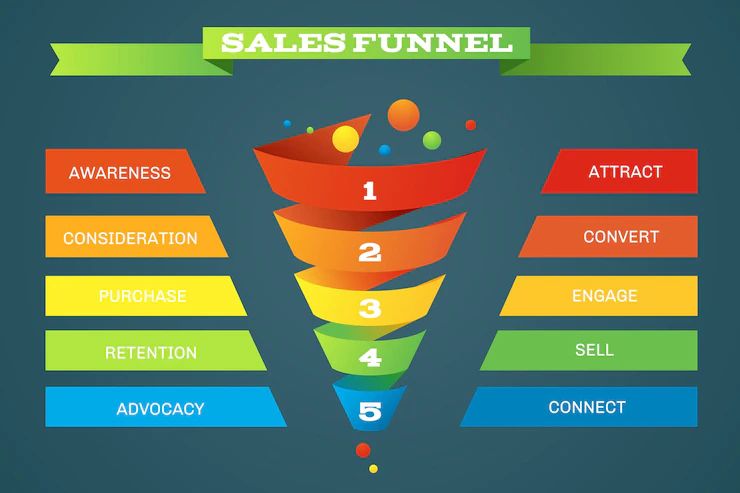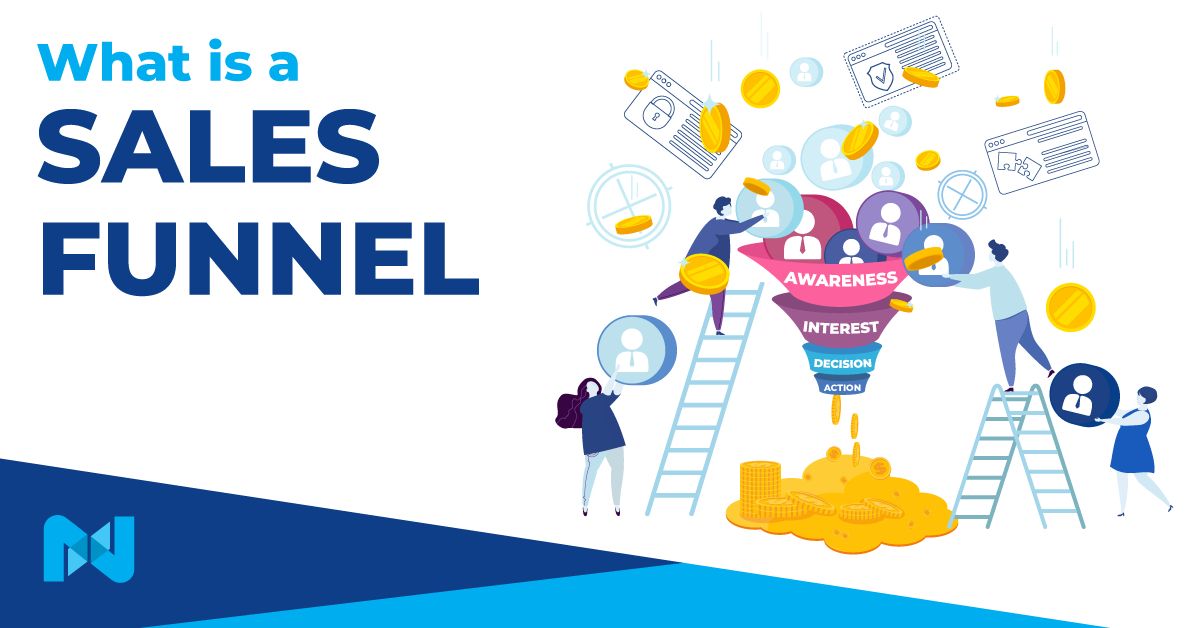The remote nature of online businesses makes customer tracking and engagement a big challenge. Unless you have access to reliable data on customer needs, your ecommerce venture can seem like a leap into the dark.
Whether you’ve been in the marketplace for some time or just venturing out, you need full control of your company's sales process.
And the sales funnel offers you just that.
Today, we’ll look at what a sales funnel is and how you should use it for lead generation, nurturing, and customer retention.
We’ll delve into:
- What Is a Sales Funnel
- The Benefits of a Sales Funnel
- The Stages of a Sales Funnel
- A Sales Funnel Example
- How To Create a Sales Funnel for Your Business
- Final Thoughts: What a Sales Funnel is and How You Should Use It
What Is a Sales Funnel?
The sales funnel visually represents a prospect’s journey to becoming a buying customer. At each stage, an effective sales funnel moves the buyer closer to making a purchase. A precise sales funnel includes stage-specific actions required to nudge prospects to take the next step.
Think of a literal funnel. A well-structured piece free from cracks will convey whatever content it gathers without loss.
On the other hand, a broken marketing funnel will cause prospect leakage at different stages, resulting in minimal (or zero) conversions.
It doesn’t have to be this way, though. It's possible to seal these loopholes. Start by understanding your potential customers’ needs and taking appropriate action at each stage.
The Benefits of a Sales Funnel
A sales funnel harmonizes lead teams’ efforts to optimize a company’s sales process. Marketing teams create awareness and nurture prospects into the consideration stage. Then sales teams convert them into buying customers.
Here are some specific marketing funnel benefits:
- Understanding the customer’s journey: Analyzing customer behavior at each sales funnel stage can help you pinpoint which holes to plug.
- Targeted marketing efforts: Knowing the audience’s interests at every step of the conversion funnel enables you to implement stage-relevant marketing techniques.
- Higher conversion rate: Defining sales funnel activities applicable to particular stages can restrain you from attempting hurried sales, which puts prospects off.
The Stages of a Sales Funnel

Although business marketing models vary, there are typically four different sales funnel stages.
Stage 1: Awareness
This is where prospects become aware of your product or service — usually through social media, google search, radio/TV, billboards, and word of mouth.
Whether prospects move past the awareness stage depends on the effectiveness of your marketing strategy at the top of the funnel.
Stage 2: Interest
Prospects evaluate your offer based on their needs in this stage. They will conduct competitive research to determine whether your offer is the best fit.
Stage 3: Decision
Now, the prospect is interested in the finer product and buying process details, such as price, quality variations available, and shipping options. Your salesperson can persuade the prospect with calls, follow-up emails, and webinars to push them to the action stage.
Stage 4: Action
The action stage is the climax of the sales pipeline. If prospects didn’t buy, that’s not the end of the sales process. Targeted nurture campaigns can keep them in line for future purchases.
A Sales Funnel Example
Let’s assume you own a skincare product online store. After conducting a buyer persona profiling, you aim at a target audience of men and women aged 25–50 who are mostly on Facebook.
You create a landing page with a form on which prospects can sign up for a lead magnet in exchange for their email addresses. The lead magnet may be a free 30-day step-by-step downloadable pdf skincare guide.
You drive traffic to your website by running a lead generation ad on your Facebook page. Prospects fill out the form with their emails and download the lead magnet. They’ve moved from the awareness to the interest stage.

The next stage involves nurturing the leads on your email list. You share specific types of content to educate them about your product.
Your email messaging (drip) campaign bears fruit when subscribers move past the decision stage and become paying customers.
Your repeat customers are so excited that they voluntarily become brand advocates. Their testimonials and referrals are attracting new leads.
And the sales process goes on and on.
How To Create a Sales Funnel for Your Business
Step 1: Build a Landing Page
Landing pages are 72% more likely to engage potential customers than product pages. Therefore, make this destination your website visitors’ first port of call.
Make your landing page more effective by:
- Including only one clear Call-to-Action (CTA)
- Excluding other attention grabbers such as site navigation
- Focusing content on a single goal for targeted audiences
- Including audience-specific product descriptions
- Optimized more for marketing campaigns than SEO.
Step 2: Make a Valuable Offer
As discussed earlier, place an irresistible lead magnet on your landing page, such as:
- Ebooks
- Webinars
- White papers
- Training videos
- Product samples
Step 3: Start Nurturing
The prospects who submitted their contact information have moved from the awareness to the interest stage. Share product-related educational content through a sustained email nurture series to move them to the decision stage.
Step 4: Upsell
Entice the prospects at the decision stage with meaningful incentives to persuade them to make a purchasing decision.
Step 5: Keep the Sales Cycle Going
Implement a two-pronged approach — keeping your current clients and landing new ones.
Also, learn why prospects didn’t purchase and focus your follow-up efforts on addressing their concerns. Turn buyers into repeat customers by continually improving customer experience.
Final Thoughts: What a Sales Funnel is and How You Should Use It
A sales funnel will help you establish, track, and achieve your revenue goals. It’ll inform you on what, where, and how to intervene to nurture your prospects into paying customers.
But first things first.
You need a reliable online store solution on which to build and support your sales funnel. Nexcess’s fully managed WooCommerce hosting plan comes readily optimized for quick load times, secure operation, and ease of use.
Get started today with our intuitive online StoreBuilder.
How this article was created
This is an original article written by Maddy Osman, a business owner with first-hand experience with sales funnel tactics. Maddy grew her business from a startup to a full-fledged agency with brands known far and wide in the technology industry. Maddy shares her expertise on optimizing your online business for conversions in various stages. Nexcess ecommerce experts have vetted this article for quality and accuracy.

